Considered
 187
187
of Research
 43
43
Examined
 11
11
Interviewed
As a certified fitness trainer, I’m often asked for recommendations on weightlifting belts.
I wanted to find the best ones, so I teamed up with a few colleagues and clients. I spent hours researching weightlifting belts, and we tested over 40 belts, and came up with a list of the best ten that stood out.
Below, I will closely examine the best weightlifting belts on the market today and provide some guidance that will help you get the right weightlifting belt for you.
The Best Weightlifting Belts
- Best Overall Weightlifting Belt: Rogue
- Cheapest Weight Lifting Belt: Harbinger 4-Inch Nylon Belt
- Best Weight Lifting Belt for Deadlifts: Dark Iron Fitness
- Best Weightlifting Belt for CrossFit: ProFitness
- Best Weightlifting Belt for Core Support: Steel Sweat
- Most Comfortable Weightlifting Belt: Fire Team Fiit
- Best Hybrid Weightlifting Belt: RitFit
- Best Weightlifting Belt for Powerlifting: Iron Bull Strength
- Best Adjustable Weightlifting Belt: Master of Muscle
- Best Comfortable Weightlifting Belt: Harbinger Weightlifting Belt
Our Top Weightlifting Belts (December 2025)
1 - Rogue (Best Overall)
- Material: Premium leather. Buckle: Single prong
- metal. Width: 4 inches. Thickness: 10mm.
Pros and Cons
Pros
- 5-inch panel tapers to 4 inches at the front.
- Best-in-class Velcro closure provides a custom-style fit.
- Stainless steel loop has plenty of strength
- Manufactured with pride in the USA.
Cons
- The branding is a bit over the top.
Who is it for?
Who is it for?
- Serious lifters seeking top-quality support
- Athletes needing a durable, versatile belt for varied workouts
Who is it not for?
- Beginners looking for a basic, budget-friendly option
Final Verdict
The Rogue offers unparalleled support and durability, making it a top pick for serious athletes. Its high-quality construction and materials ensure long-term usage.
After years of lifting and trying various belts, Rogue USA Nylon Lifting Belt was a game-changer. It quickly became my go-to, and many of my fellow lifters felt the same.
And here’s why.
First of all, the Rogue USA Nylon Lifting Belt provided lots of support not only for the back but for the often-overlooked abdomen.
In addition, while most of our testers prefer traditional buckles to Velcro, the length and quality of the Velcro strap here alleviated many of their concerns about such closures.
And finally, materials and stitching were first-rate throughout and reinforced the feelings of comfort and stability as the reps added up. And, as seven-time Mr. Olympia Arnold Schwarzenegger says "The last three or four reps is what makes the muscle grow.”
2 - Dark Iron Fitness (Best for Deadlifts)
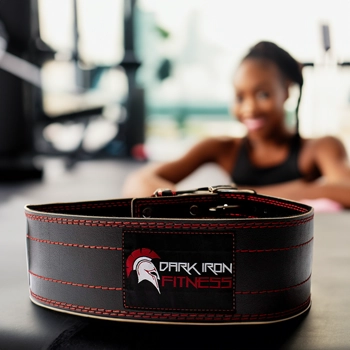
- Material: High-quality leather. Buckle: Double prong
- metal. Design : Adjustable
- sturdy.
Pros and Cons
Pros
- Fashioned from high-quality buffalo hide.
- The 4-inch width provides optimal lumbar support.
- Feels broken-in almost from the first lift.
Cons
- It’s not going to win any fashion awards.
Who is it for?
Who is it for?
- Powerlifters focused on deadlifts
- Those needing extra lumbar support
Who is it not for?
- Casual gym-goers who prioritize flexibility over support
Final Verdict
Dark Iron Fitness is ideal for heavy lifting, particularly deadlifts, due to its sturdy leather build. Not the most flexible, but it excels in providing solid back support.
I remember my coach, a huge fan of Jon Pall Sigmarsson, always emphasizing the importance of the deadlift. When I tried the Dark Iron Fitness belt, it felt like a solid embrace, especially during those intense deadlift sessions.
Deadlift is one of the oldest known forms of weightlifting but many believe it also puts the greatest stress on the back and abdomen.
The Dark Iron Fitness belt is a solid leather weightlifting belt that holds you fast when stresses are at their worst.
It’s 4 inches wide all the way around and features a robust double-prong metal buckle.
The belt is fashioned from buffalo hide leather which impressed our test group with its comfortable, supple feel.
This belt also holds your mid-section firmly every time so you can get on with setting new personal bests.
3 - ProFitness Workout Belt (Best for CrossFit)
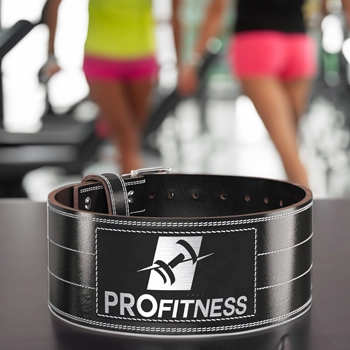
- Material: Durable leather. Buckle: Single prong. Stability: Core support. Price: Affordable.
Pros and Cons
Pros
- 100-percent genuine cowhide leather.
- Double-prong steel buckle provides a rock-solid hold.
- The width provides plenty of support without impeding movement.
Cons
- Quality of riveting can sometimes be an issue.
Who is it for?
Who is it for?
- CrossFit enthusiasts
- Lifters looking for a belt that allows mobility
Who is it not for?
- Lifters who need very rigid lumbar support
Final Verdict
ProFitness is designed for dynamic movements, making it perfect for CrossFit. It combines flexibility with adequate support for various exercises.
Having ventured into CrossFit sessions, I quickly understood its rigorous demands. The ProFitness Genuine Leather Belt became my trusty companion, ensuring I was both comfortable and supported during those intense WODs.
The ProFitness Genuine Leather Belt is marketed as a “workout” belt, not a “weightlifting” belt.
That should provide some indication that the designers here were focusing on versatility.
Everyone in our test group agreed the belt provided lots of lumbar and abdominal support and that little or no adjustment was needed when moving from lift to lift.
“You don’t train to picture yourself second place on the podium.”
- Mat Fraser, Two-time CrossFit Champion
At the same time, the belt in no way impeded movement which is really important in CrossFit.
4 - Steel Sweat (Best for Core Support)
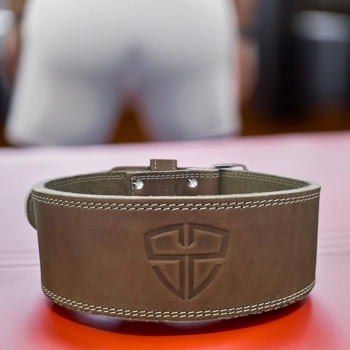
- Material: Full grain leather. Width: 4 inches. Buckle: Single prong. Design: Vegetable tanned.
Pros and Cons
Pros
- High quality full-grain genuine leather.
- Comfortable after a short break-in period.
- High durability single-prong roller buckle.
- Reasonable price point.
Cons
- Lack of any color options.
- May have overdone it a bit with the logo.
Who is it for?
Who is it for?
- Athletes needing strong core stabilization
- Users who appreciate leather quality and comfort
Who is it not for?
- Those preferring a lightweight nylon belt
Final Verdict
Steel Sweat offers exceptional core support with high-quality leather, ideal for serious training sessions. It's comfortable yet robust enough for intensive use.
The moment I strapped Steel Sweat Weightlifting Belt on, I felt an immediate sense of security and support around my core.
It’s 4 inches wide all the way around and fashioned from premium full-grain cowhide. The single-prong buckle is made of stainless steel and the belt has a soft, comfortable suede lining.
According to a study published in the National Library of Medicine, weightlifting belts can help you perform more effective squats [1].
Our clients also found this weightlifting belt allowed them to pursue deadlifts and squats with more aggression and confidence.
5 - Fire Team Fit (Most Comfortable)

- Material: Lightweight nylon. Buckle: Slide stop buckle. Features: Hook and loop for adjustment.
Pros and Cons
Pros
- Very light and extremely comfortable.
- Won’t impede your movements no matter how aggressive.
- Velcro and stainless steel closure mechanism.
- Fortified support in the lower back area.
Cons
- Tends to run a bit small.
- Not as durable as a padded leather belt.
Who is it for?
Who is it for?
- Users seeking comfort during long training sessions
- Those engaging in a variety of exercises
Who is it not for?
- Powerlifters needing the most rigid support
Final Verdict
Fire Team Fit is known for its comfort and adaptability, suitable for extended use across various workouts. However, it may not suit those who need extremely stiff support.
Fire Team Fit Weightlifting Belt was a revelation in comfort, making my lifting sessions feel more fluid and less restrictive.
The contour shape allows it to accommodate a range of moves without ever imposing itself, and for this reason, it captured our Best Belt for Olympic Lifting designation.
Fire Team Fit takes its lead from soft fabric belts of yesteryear. And while this isn’t exactly a “fabric” belt, it is incredibly pliable and fits more like a compression wrap than a weightlifting belt.
The lumbar support is superb and the abdominal support is firm without binding. The belt is also very light by weight belt standards so at times you’re going to forget you have it on.
6 - Harbinger 4-Inch Nylon Belt (Cheapest Option)

- - Dimensions : Not available
- - Maintenance : Easy to maintain
- - Design : Nylon material, durable
- - Warranty : No
- - Premium materials : Yes, high-quality nylon
Pros and Cons
Pros
- 4 inches wide with a 3-inch support band.
- Stainless steel roller buckle for simple adjustments.
- Only weighs about a pound.
Cons
- Lining can be a little abrasive when you sweat.
Who is it for?
Who is it for?
- Beginners and casual lifters
- Budget-conscious users
Who is it not for?
- Advanced lifters looking for premium materials
Final Verdict
The Harbinger 4-Inch is an affordable option that provides good support for casual use. While it's cost-effective, it doesn't match the durability of higher-end models.
When I was just starting out on my fitness journey, budget was a concern. That's when I stumbled upon the Harbinger 4-Inch Nylon Belt. It was affordable and gave me the support I needed during those early days.
While it doesn’t have the cache of a top-of-the-line leather weightlifting belt, who really cares as long as it does what it’s supposed to do?
And the Harbinger 4-Inch does that. Our testers noted that it provides solid, dependable lumbar and abdominal support, and a better-than-average hold for a Velcro/roller buckle lever system.
Also, the high-quality ripstop nylon fabrication means it will be around for a while. It’s not going to set the weightlifting fashion world on fire but it doesn’t have to. It just has to save your back and abs from injury.
7 - RitFit (Best Hybrid)

- - Dimensions : Not available
- - Maintenance : Simple maintenance
- - Design : Contoured design for comfort
- - Warranty : No
- - Premium materials : Yes, quality materials for durability
Pros and Cons
Pros
- Soft, comfortable tricot lining.
- 6 inches at its widest for full midsection coverage.
- Reduces spinal flexion and provides outstanding abdominal support.
- Great for all of your weightlifting exercises.
Cons
- We weren’t thrilled with the Velcro closure.
Who is it for?
Who is it for?
- Those who alternate between lifting and other gym activities
- Users who prefer wider belts for better coverage
Who is it not for?
- Athletes looking for a specialized lifting belt
Final Verdict
RitFit's hybrid design makes it versatile for gym-goers who mix weightlifting with other fitness routines. It provides broad coverage but might lack the specialization serious lifters seek.
In my early days of lifting, I struggled with core stabilization. Then a trainer recommended the RitFit Weightlifting Belt. It was a game-changer, providing me with the stability I needed for each lift.
There was very little adjustment needed and never a sense that the belt wasn’t up to the task.
At 6 inches wide, this is one of the widest belts around. That, and the ergonomic design that’s contoured to your physique helps to explain how it goes about providing that remarkable stability.
8 - Iron Bull Strength (Best for Powerlifting)

- - Dimensions : Not available
- - Maintenance : Easy
- - Design : Leather with double prong buckle
- - Warranty : No
- - Premium materials : Yes, premium leather
Pros and Cons
Pros
- Fabricated from a single 10 mm thick piece of suede.
- Stainless steel double-prong buckle and rock-solid rivets.
- 10 different adjustments.
Cons
- Sizing can sometimes be an issue.
Who is it for?
Who is it for?
- Serious powerlifters and bodybuilders
- Athletes needing maximal lumbar support
Who is it not for?
- Those who need a belt for general fitness activities
Final Verdict
Iron Bull Strength is tailored for powerlifting, offering maximum support and thickness. It's not suitable for lighter or general gym activities due to its heavy-duty design.
When I tried the Iron Bull Strength belt, it felt like it was made just for me - straightforward, sturdy, and reliable.
It’s 4 inches wide all the way around with bold double stitching and a strong stainless steel double prong buckle. And that’s about it.
Members of our test group were impressed with how the belt enhanced their stability and overall performance during squats, bench presses and deadlifts, which earned this our Top Belt for Powerlifting designation.
Overall, it’s a single piece of high-quality, tough but supple suede that actually feels great when you put it on.
9 - Master of Muscle (Best Adjustable)
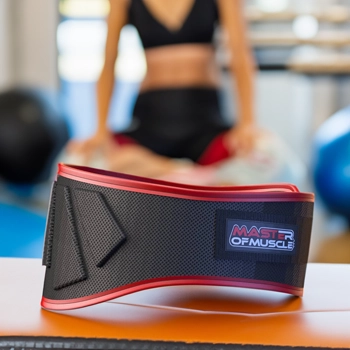
- - Dimensions : Not available
- - Maintenance : Low maintenance
- - Design : Lightweight neoprene
- - Warranty : No
- - Premium materials : Yes, quality neoprene
Pros and Cons
Pros
- Spares your sides from nasty abrasions.
- Stabilizes all aspects of your core front and back.
- Remarkably affordable for such a versatile belt.
Cons
- Uninspired design.
Who is it for?
Who is it for?
- Users requiring quick adjustments between workouts
- Athletes who vary their training intensity and exercises
Who is it not for?
- Those who prefer leather over nylon for durability
Final Verdict
Master of Muscle excels in adjustability and is great for athletes who need to switch between different exercises quickly. Its nylon construction may not satisfy all durability needs.
During one of my intense training sessions, I was switching between different types of lifts and needed a belt that could adapt quickly. The Master of Muscle Weightlifting Belt was a revelation.
Its adjustability feature made transitions seamless, letting me focus on my form and performance.
With the Master of Muscle Weightlifting Belt, you just pull or release the Velcro strap to achieve your desired tension and that’s it. You’re ready to rumble.
A solid majority of our testers commented on how easily the belt adjusted and how firmly it reset.
10 - Harbinger Weightlifting Belt (Best Comfortable)
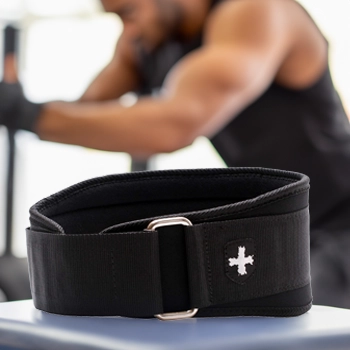
- - Dimensions : Not available
- - Maintenance : Easy
- - Design : Foam core for comfort
- - Warranty : No
- - Premium materials : Yes, foam and abrasion-resistant outer material
Pros and Cons
Pros
- The foam core and tricot lining provide above-average comfort.
- The 5-inch width and firm Velcro closure provide lumbar and abdominal support.
- High-quality stitching throughout.
Cons
- Customer service of Harbinger isn’t that great.
Who is it for?
Who is it for?
- Those prioritizing comfort and ease of use
- Casual to intermediate lifters
Who is it not for?
- Competitive athletes who require a belt with professional-grade support
Final Verdict
Harbinger's comfortable design makes it a favorite among casual and intermediate lifters. While very user-friendly, it may not meet the rigorous demands of competitive lifting.
After being satisfied with the 4-inch Harbinger nylon belt, I decided to give their other belt a try. Just like its predecessor, it didn't disappoint. It was functional, affordable, and got the job done without any unnecessary frills.
Our testers appreciated the 5-inch width, the light weight of the belt, the foam core that allows the belt to give a bit during squats.
One minor sticking point is that while the tricot lining is nice and soft, that effect is somewhat undermined by the rough stitching along the top and bottom that can be pretty abrasive.
How We Tested Weightlifting Belts
Here's how we chose the best weightlifting belts:
1. Diverse Group of Testers
We assembled a team of weightlifters with varying levels of experience, from novices to seasoned professionals. This ensured that the belts were tested across different skill levels and body types.
Each tester used the belts during their regular workout sessions, which included a variety of exercises like squats, deadlifts, and bench presses. This helped us gauge the belts' performance in actual weightlifting scenarios.
2. Comfort and Adjustability
Our testers evaluated how each belt felt during workouts, noting any pinching, excessive tightness, or other discomforts.
We assessed how easy it was to adjust each belt, especially during quick transitions between exercises. This is crucial during competitions or intense workout sessions.
3. Durability
The belts were subjected to stress tests, including heavy lifts and rapid adjustments, to check their resilience. We also noted the quality of materials and stitching.
4. Material
We examined the quality of materials, such as leather, nylon, or neoprene, and how they impacted the belt's performance and feel during lifts.
5. Price
We evaluated the belts in terms of value for money. While price isn't always indicative of quality, we wanted to ensure that our top picks offered excellent performance at a reasonable cost.
Types of Lifting Belts
In general, weightlifting belts tend to fit into the following categories.
1. The Cardio Belt
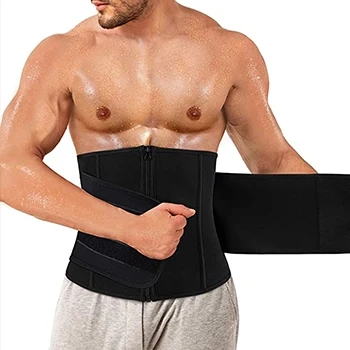
This type of belt is typically used by those looking to shed pounds by way of weightlifting.
On the plus side, this type of belt is very light and flexible and helps lifters achieve and maintain proper posture
On the downside, they’re not going to provide the lumbar support that extreme lifters require.
The cardio belt user is one who:
- Often practices a wide range of free weight exercises and sports.
- Is looking to gain not only muscle but also cardio benefits.
- Is often looking to improve their lifting posture.
You usually won’t find someone wearing this type of belt to perform deadlifts.
2. The Supportive Belt
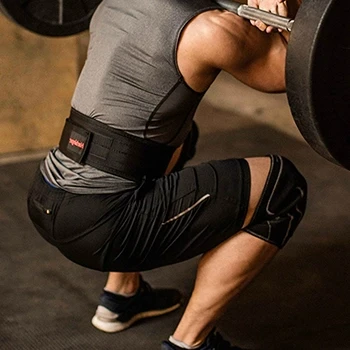
Those who come to deadlifting with a history of back injury will want to consider wearing a supportive belt.
These belts have a lot in common with heavy leather belts in that they’re thick and they often have a core of memory foam that contours to your body, which mimics the way leather conforms to your body over time.
On the upside, they usually have a Velcro closure that allows for a more precise fit. On the downside, that Velcro closure means these belts aren’t great for hardcore lifting.
People who could benefit from this type of belt are those who:
- Have back issues but wish to explore weightlifting.
- Have a difficult time maintaining proper form.
- Participate in strength training using free weights.
3. The Strength Belt
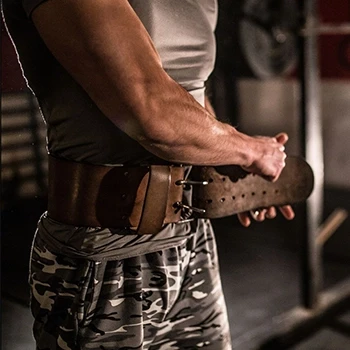
These are belts for people engaged in the upper echelons of weight training.
Strength belts are almost always leather or padded leather belts with single or double-prong stainless steel closures.
As the leather breaks in, the belt conforms to your body’s contours which makes for outstanding support both in the lumbar region and the abdomen.
On the upside, these leather contoured belts will be there for you as you push the performance envelope. On the downside, they may be too cumbersome for CrossFit or other, more active types of workout.
People who could benefit from this type of belt are:
- Those with well-established form.
- Those with an eye on competitive lifting.
- Those who regularly engage in serious powerlifting.
Buyer's Guide
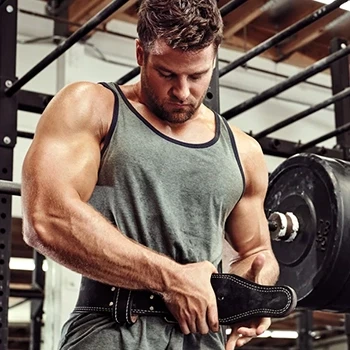
Here's what to pay attention to when choosing a weightlifting belt.
1. Width
The wider the belt, the better the lumbar support and overall stability.
Six inches is about as wide as any weightlifting belt has any business being because it runs the risk of crimping the lower ribs and creating unintended problems.
Most of the best weightlifting belts will be around 4 or 5 inches wide.
2. Thickness
Thickness will also be a function of what you intend to use the belt for. If you want it for CrossFit, a thinner, cardio-style belt should do fine.
If, however, you want a belt for powerlifting, you’ll want one that’s 12 or 13 mm thick (approximately 1/2 inch) and is made of genuine leather with a single or double prong buckle.
3. Adjustability
Different lifters have different reasons for wanting different degrees of adjustability. For those with back or posture issues, it’s often important that their belt offers precise adjustability. And for that, Velcro is the only way.
Others have their lifting routine and posture down. To them, the belt is essentially a backup, not a primary component of the weightlifting process. So single or double-prong buckles will do the trick.
5. Leather
Leather weightlifting belts normally have a more conical shape in that the width of the belt is more or less the same all the way around.
Leather is normally used by experienced lifters for powerlifting because it helps keep everything properly aligned when stresses are at their worst.
It’s not usually as comfortable as nylon but you’re not buying it because you want to be comfy (more on that in a moment).
6. Nylon
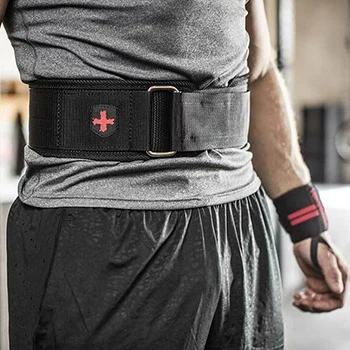
Nylon belts are lightweight, affordable and great for those into recreational lifting.
They’re more comfortable right out of the box and, if they have a Velcro closure, adjust faster and more precisely than leather belts.
You won’t see many powerlifters wearing nylon belts just because according to an article on Sciencing website, their material strength isn’t always sufficient to buttress form when pushing the performance envelope [2].
7. Comfort
When it comes to weightlifting belts, “comfort” is a relative term.
You can’t reasonably expect to wrap a 4 to 6-inch wide strap of nylon or leather around your midsection and expect it to be as comfortable as the belt you use to hold up your suit pants.
Leather belts, in particular, start off very stiff and might even produce some bruising in the waist at the beginning.
So if comfort is one of your prime concerns, you’ll want to consider a nylon belt to start with. Even then, however, temper your comfort expectations.
How to Maintain Weightlifting Belts
Over time, sweat, grime, and regular wear and tear can degrade the material of the belt, potentially affecting its performance. But, it can last years if properly cared for.
For leather belts, it's crucial to keep them clean and conditioned. After each use, wipe down the belt with a damp cloth to remove sweat and dirt. Every few months, apply a leather conditioner to keep the material supple and prevent it from drying out.
For nylon belts, a gentle hand wash with mild soap and water will suffice.
Always avoid machine washing or using harsh chemicals, as these can damage the belt's integrity.
When storing, lay the belt flat or hang it up, avoiding folding or crumpling, which can deform its shape.
Benefits of Using Weightlifting Belts
One of the primary advantages is the increase in intra-abdominal pressure. When a lifter inhales deeply before a lift and braces their core against the belt, it creates a pressurized environment inside the abdomen.
This pressure acts as a supportive cylinder around the spine, providing stability and reducing the stress on the lower back. This can lead to a reduction in spinal flexion, extension, and lateral bending.
Furthermore, a weightlifting belt can enhance proprioception, the body's ability to sense its position in space. The tactile sensation of the belt against the skin can remind lifters to maintain proper form and posture during a lift.
Finally, a study on Research Gate says that weightlifting belts are beneficial during resistance training [3].
FAQs
What Are the Benefits of Weightlifting Belts?
The benefits of weightlifting belts are increased stability, lumbar and abdominal support, and assistance with maintaining proper form throughout the lift.
When Should You Use a Weightlifting Belt?
You should use a weightlifting belt if you are serious about getting into strength training. Once you’ve decided to get serious yourself, the type of belt you get will depend on which kind of lifting you want to focus on.
Our Verdict on the Best Weightlifting Belt
Having spent countless hours in the gym and tried numerous belts over the years, I can confidently say that not all weightlifting belts are made the same.
From my personal experience, if there's one belt I'd recommend to both novices and pros alike, it's the Rogue USA Nylon Lifting Belt.
It's not just about the comfort or versatility; but the confidence it instills when you wear it. Whether you're doing heavy squats or deadlifts, this belt feels like a trusty companion.
Its blend of quality and affordability is unmatched, which is why it topped our list.
Our #1 Weightlifting Belt
Rogue (Best Overall)
Rated With Total Shape's Scoring System
- 5-inch panel tapers to 4 inches at the front.
- Best-in-class Velcro closure provides a custom-style fit.
- Stainless steel loop has plenty of strength
- Manufactured with pride in the USA.
- Get the BEST PRICE until the end of December
- The branding is a bit over the top.
About The Author
You May Also Like

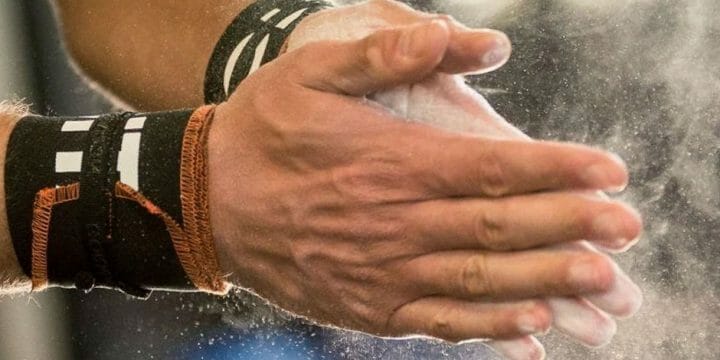


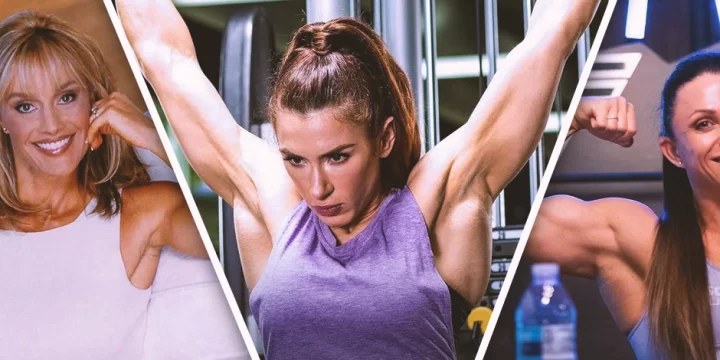
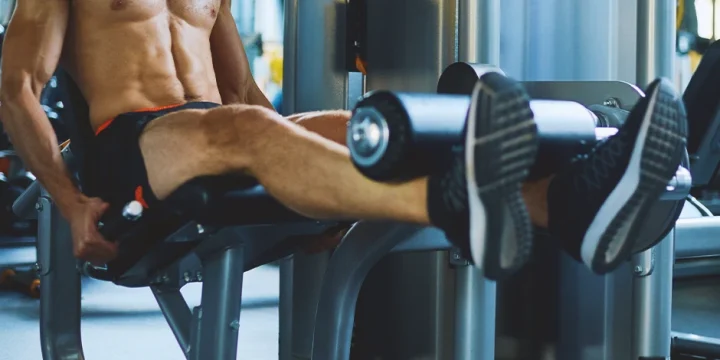
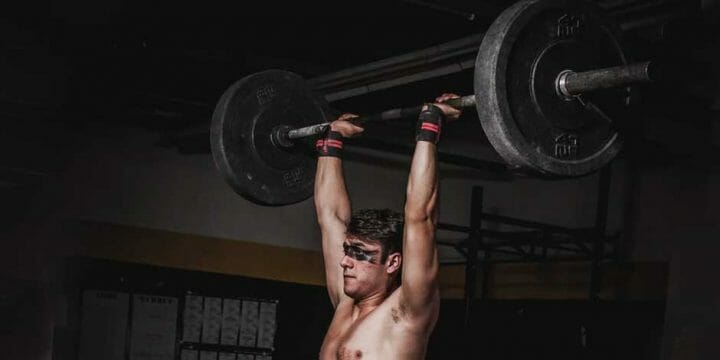
Great recommendations!
Very informative article regarding weightlifting belts! I will definitely buy your best pick. Thanks!
Stay safe and healthy!
Cheers!
I prefer a belt with a lighter pressure that doesn’t wear out quickly. The article gave great insight into some new options.
It’s amazing how the Steel Sweat belt combines robust leather with comfort. Investing in high-quality materials like full-grain leather really seems worth it for serious lifters